A New Creationist Cosmology: In No Time at All Part 1
D. Russell Humphreys, Ph.D.
Introduction
One of the issues that concern many people who wish to adopt young-earth creationism as a valid view of earth history is the question of how stars can be seen many millions of light years away if only a few thousand years have passed since they were created. Dr. Russell Humphreys, a previous researcher at ICR, spent years working on this problem and has developed a creationist cosmology that seems to resolve this question.
On the fourth day of creation, how long did it take God to make the stars and bring their light to earth? No time at all, according to clocks here on earth. That is what Humphreys concludes from his new creationist cosmology research. The cosmology presented in his 1994 book, Starlight and Time,1 had the light getting to earth in a finite amount of time, not instantaneously. The general features of that cosmology—a universe centered upon our galaxy, expansion of space, and gravitational time dilation—still appear to be correct. But Humphreys was never fully satisfied with its details because a) the solution did not provide enough time dilation for nearby stars and galaxies, and b) it was based on a metric—a solution of Einstein’s gravity equations—that was too complex to analyze fully.
A referee for a subsequent relativity paper Humphreys wrote insisted that he derive a new metric to support the paper’s conclusions. After several months of mathematical work, Humphreys found the solution and the Journal of Creation published his results.2 The article’s appendix contains the new metric and derivation. In a series of Acts & Facts articles, we will describe qualitatively the implications of this new metric and how it explains the cosmology of the creation events.
Time Stands Still
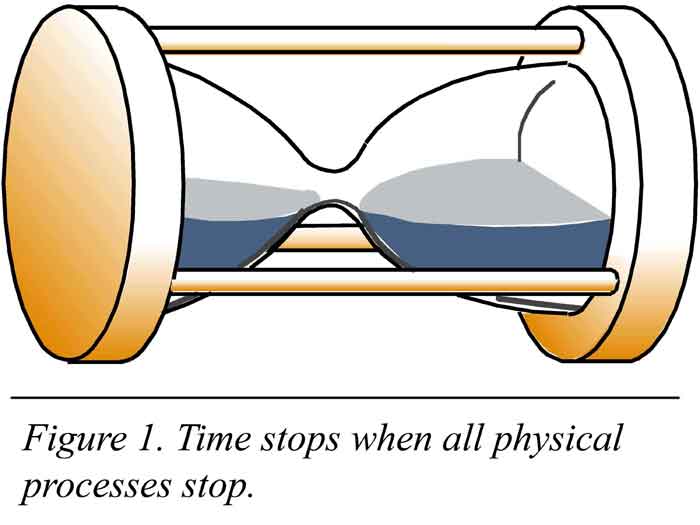 The new metric is not complicated, compared to many modern ones. Because it is simple and yet rigorous, it shows a feature of gravitational time dilation that nobody had noticed before. The feature was implicit in many previous metrics, but it had been obscured by the effects of motion. Humphreys calls this feature of time dilation achronicity, or “timelessness.” It causes clocks and all physical processes—hence, time itself—to be completely stopped in a region that could be very large. This is in contrast to the time dilation around a black hole, in which time is completely stopped only at a certain exact distance from its center, at the “event horizon.”3 In his 2008 article, Humphreys showed how this new metric led straightforwardly to achronicity. In the last five pages of the paper, he applied the time dilation achronicity to develop a new creationist cosmology.
The new metric is not complicated, compared to many modern ones. Because it is simple and yet rigorous, it shows a feature of gravitational time dilation that nobody had noticed before. The feature was implicit in many previous metrics, but it had been obscured by the effects of motion. Humphreys calls this feature of time dilation achronicity, or “timelessness.” It causes clocks and all physical processes—hence, time itself—to be completely stopped in a region that could be very large. This is in contrast to the time dilation around a black hole, in which time is completely stopped only at a certain exact distance from its center, at the “event horizon.”3 In his 2008 article, Humphreys showed how this new metric led straightforwardly to achronicity. In the last five pages of the paper, he applied the time dilation achronicity to develop a new creationist cosmology.
Space Is Like a Scroll
The first step in understanding this new cosmology is to recognize that space is not empty. Both science and Scripture strongly imply that space is a solid material that we cannot see or feel, though quantum field theory suggests it is extremely dense.1 We move freely through it and it moves freely through us.4See Scriptures like Isaiah 40:22: “[God] stretches out the heavens like a [tent] curtain” (NASB), and 16 other similar verses.5 These verses invite us to compare the material of space to a stretchable fabric under tension,6 like that in a trampoline.
Next, think about the space we live in. It appears to have only three dimensions, or directions—length, width, and height. Lay a piece of typing paper flat on a table. It is 8.5 inches wide by 11 inches long, but it is only 0.003 inches thick. It does not occupy much of the height direction at all. Now roll up the paper like a scroll. You used the third dimension, height, in the air above the table to roll it up, and the thinness of the paper allowed you to do so. So if an object is thin in one of its dimensions, you can roll it up. But here is an amazing thing—Scripture says the same thing about the heavens:
And the heavens shall be rolled up like a scroll. (Isaiah 34:4, NKJV)
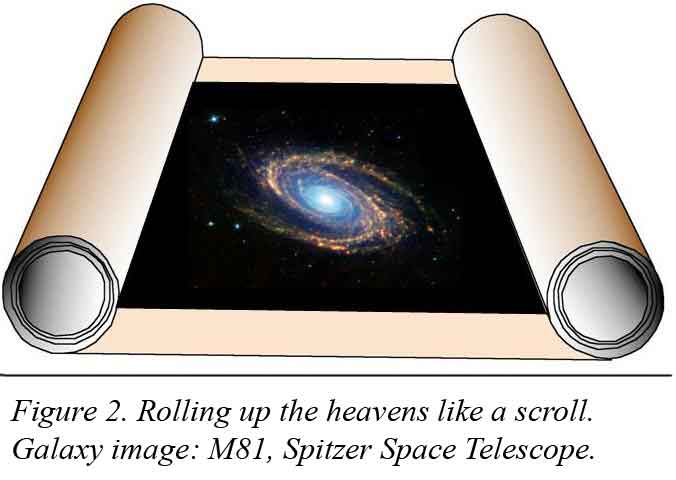 The context here is the “host of heaven,” which includes the stars, and “the heavens.” This is the space that contains the stars. Here again, God depicts the heavens as a material that He can manipulate. In the three directions we can see, the heavens are very thick. Yet God says He will roll them up like a scroll.7 That implies that the heavens are thin in a fourth direction that we cannot see. Moreover, there must be more room in that fourth direction that allows the rolling up to occur. The future tense of this verse implies that the heavens are not in a rolled-up condition at present. In the fourth dimension that we cannot perceive, space is flat, like an unrolled scroll or cloak.8 The three dimensions we can see would exist as a thin sheet within a larger four-dimensional space, which some physicists call “hyperspace.”9 As Humphreys pointed out in Starlight and Time,10 the extra dimension makes sense of the equations of Einstein’s general theory of relativity by giving room in which the “spacetime continuum” can be bent.11
The context here is the “host of heaven,” which includes the stars, and “the heavens.” This is the space that contains the stars. Here again, God depicts the heavens as a material that He can manipulate. In the three directions we can see, the heavens are very thick. Yet God says He will roll them up like a scroll.7 That implies that the heavens are thin in a fourth direction that we cannot see. Moreover, there must be more room in that fourth direction that allows the rolling up to occur. The future tense of this verse implies that the heavens are not in a rolled-up condition at present. In the fourth dimension that we cannot perceive, space is flat, like an unrolled scroll or cloak.8 The three dimensions we can see would exist as a thin sheet within a larger four-dimensional space, which some physicists call “hyperspace.”9 As Humphreys pointed out in Starlight and Time,10 the extra dimension makes sense of the equations of Einstein’s general theory of relativity by giving room in which the “spacetime continuum” can be bent.11
The Analogy of the Trampoline
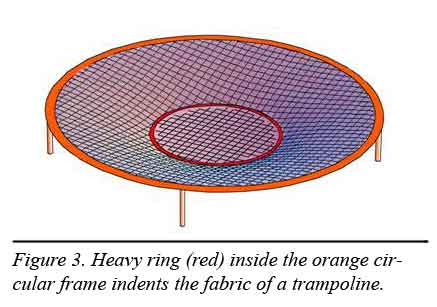 So, if the heavens are thin in one dimension, and like a stretchable fabric under tension, we can compare them to the fabric in a trampoline. Put a heavy ring inside the circular frame on the trampoline. Notice that the weight of the ring makes a dent in the fabric of the trampoline, as in Figure 3. In just the same way (but with more dimensions), Einstein’s gravity equations say the presence of a mass bends the fabric of space.12 For dents that are not very deep, this picture also fits Newton’s gravity equations.13
So, if the heavens are thin in one dimension, and like a stretchable fabric under tension, we can compare them to the fabric in a trampoline. Put a heavy ring inside the circular frame on the trampoline. Notice that the weight of the ring makes a dent in the fabric of the trampoline, as in Figure 3. In just the same way (but with more dimensions), Einstein’s gravity equations say the presence of a mass bends the fabric of space.12 For dents that are not very deep, this picture also fits Newton’s gravity equations.13
The slope of the fabric is proportional to gravitational force. If we put a marble on the sloped part, it will roll inward toward the ring. Notice that if we put the marble inside the ring, it sits in a flat region and does not try to roll anywhere. This corresponds to the fact that in both Newton’s and Einstein’s gravity equations, the gravitational force is zero inside an empty hollow sphere.
The depth of the dent at any given point is proportional to the gravitational energy14 at that point. Inside the ring, all points are at the same depth below where they would be if we had not put the ring on the trampoline. This corresponds to the fact that in both Newton’s and Einstein’s equations, particles inside a hollow sphere of mass have a lower15 gravitational energy than they would if the hollow sphere did not exist.
The First Day of Creation
Now that we have the trampoline analogy in place, we are ready to understand some of the gravitational implications of creation. Recall that Genesis 1:2 mentions water:
And the earth was without form, and void; and darkness was upon the face of the deep. And the Spirit of God moved upon the face of the waters. (KJV)
Notice “the deep.” Its mass was on the order of twenty times that of all the galaxies within the viewing range of the Hubble space telescope.14 This was probably ordinary liquid H2O and would have been in the shape of a ball a few light years in diameter. If Newton’s gravitational constant G had the same value then as now (not necessarily true), all of the water would be well within the event horizon of a black hole.
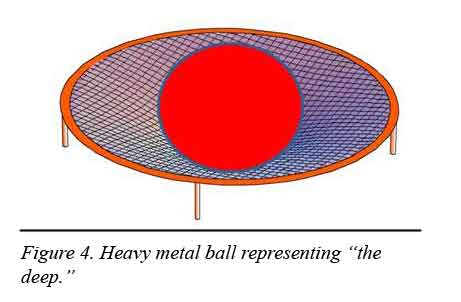 Now, replace the ring on our trampoline with a heavy metal ball to represent “the deep.” The ball would make a large dent in the fabric. The slope of the fabric around the ball is steep, meaning gravity would be strong around “the deep.” Conditions would be complicated, and probably beyond our present understanding of physics. But, we can say that almost certainly time dilation was taking place. One ordinary-length day of time passed during which time the ball would have contracted due to gravity. But, the speed of light would limit its contraction to a few percent of the overall diameter.16
Now, replace the ring on our trampoline with a heavy metal ball to represent “the deep.” The ball would make a large dent in the fabric. The slope of the fabric around the ball is steep, meaning gravity would be strong around “the deep.” Conditions would be complicated, and probably beyond our present understanding of physics. But, we can say that almost certainly time dilation was taking place. One ordinary-length day of time passed during which time the ball would have contracted due to gravity. But, the speed of light would limit its contraction to a few percent of the overall diameter.16
The Beginning of the Second Day of Creation
At the center of “the deep,” God marked off a relatively small spherical region of water. He marked it off with a thin region of space (empty to our perceptions, but really a material) that He called “the firmament,” or in other translations “the expanse” (Genesis 1:7). The Hebrew word raqia suggests something solid that was spread out, such as the bronze hammered thin and spread over the altar of sacrifice (Numbers 16:38). The raqia is understood to consist of the same dense, intangible, and invisible material that was mentioned above, the fabric of space. Above the raqia were the rest of the waters of the deep. Above the waters was more empty space (empty to our perception, but again a material) extending out many billions of light years.16
Then, God began spreading out, or expanding, the raqia, hence giving the word its connection with “spreading out.” Somehow, God carried the waters above the firmament outward above the raqia. As the spreading out continued, the waters above the expanse would have become thinner, eventually breaking up into large and small drops of water. Then the drops would begin freezing from the outside inward. So, eventually the waters above the firmament would become a relatively thin region, shaped like a spherical shell, of ice particles.17
More to Come
We are now ready to describe the most interesting events that permit light to get from the stars to earth in only a few thousand years. Humphreys suggests that an expansion occurred, adjusting the critical potential and conditions inside and outside the mass on our imaginary trampoline. Hence, a region of timelessness would have expanded outward from earth through space, allowing physical processes and events in the outer reaches of our cosmos to proceed while clocks on earth stood still.
This cliffhanger of a story will be completed in future articles. They will address the events of the remaining days of creation and following. The timeless zone, gravity, and the speed of light interact to allow light to reach earth in a “short” period of time.
Click here to read Part 2 of the series.
References
- Humphreys, D. R. 1994. Starlight and Time. Green Forest, AR: Master Books, 67.
- Humphreys, D. R. 2008. New time dilation helps creation cosmology. Journal of Creation. 22 (3): 84-92. Available on creation.com.
- Hawking, S. W. 1988. A Brief History of Time. Toronto: Bantam Books, 87. Achronicity would exist inside the event horizon if particles and clocks there could be motionless. But, it appears impossible for objects inside the event horizon to be motionless, which allows a way for clocks to continue ticking.
- Feynman, R. P., R. B. Leighton and M. Sands. 1965. The Feynman Lectures on Physics, vol III. Reading, MA: Addison-Wesley Publishing Company, 13. Feynman, along with many other authors, points out that, surprisingly, electrons can pass freely through a perfect crystal, “almost as if they were in a vacuum.” The reason for this lies deep in the heart of quantum mechanics theory, but the effect is a matter of observation. The same effect appears to apply to visible particles moving through the fabric of the heavens, which some Scriptures also compare to a crystal (Exodus 24:10; Ezekiel 1:22, 10:1).
- Ibid, 66. See 2 Samuel 22:10; Job 9:8, 26:7, 37:18; Psalm 18:9, 104:2, 144:5; Isaiah 42:5, 44:24, 45:12, 48:13, 51:13; Jeremiah 10:12, 51:15; Ezekiel 1:22; Zechariah 12:1. Many of these verses compare the heavens to a fabric.
- Isaiah 54:2, NASB, describes the expansion of a Middle Eastern tent: “Enlarge the place of your tent; stretch out the curtains of your dwellings, spare not; lengthen your cords and strengthen your pegs.”
- An intelligent creationist friend, wishing to avoid the implications of this verse, once told Humphreys it was “only a figure of speech,” trying to imply the verse is devoid of physical meaning. But note what kind of figure of speech it is—a simile, which explains a poorly-known but real thing by comparing it to a well-known thing. This means that the heavens will be rolled up physically, not figuratively, in a way similar to the rolling up of a scroll.
- Hebrews 1:12, NASB: “And like a mantle You will roll them [the heavens] up.”
- Kaku, M. 1994. Hyperspace. New York: Oxford University Press. Because of the scriptural clues, hyperspace may be something real, not a mathematical convenience, consisting of only four spatial dimensions instead of 10 or 22.
- Humphreys, Starlight and Time, 93.
- According to relativity theory, time is yet another dimension, but it is different from the space dimensions.
- Technical note: Actually for relativity, spacetime. It is suggested that the fabric of spacetime is accelerating in this fourth spatial direction. It is probably not a linear acceleration in the fourth direction, but rather a centrifugal acceleration, with the fabric of space moving rapidly in the timeward direction and curving “upward” in the fourth spatial direction. The inertial mass of the fabric itself would be balanced at every point by the force causing the acceleration. That means that without additional mass, the fabric would be flat in the three spatial directions. Only additional inertial mass at a point would make a dent in the fabric. With this simple picture, one can derive Einstein’s gravitational field equations. It explains several longstanding puzzles: 1) Why inertial and gravitational mass are equal; and 2) how the fabric of spacetime could be very dense (as quantum field theory demands) without producing gravitational curvature (as required by astronomical observations).
- Technical note: It works out that Newton’s gravitational constant is G = 4π g2/τ , where g is the acceleration in the fourth spatial direction and τ is the tension in the fabric. Both of those quantities would be very large.
- Technical note: More precisely, gravitational potential, the gravitational potential energy per unit mass. The potential would be g times the deflection in the fourth direction relative to the position the fabric would have with no mass added. The potential is a negative number, and its physical units are velocity squared. This correctly suggests that when gravitational potential becomes on the order of minus the speed of light squared, interesting things might happen.
- Technical note: Lower, because gravitational (potential) energy is negative. It gets more negative as the dent gets deeper. To put it another way, it takes positive energy to lift an object up out of the dent.
- It is not clear how the outmost region of space terminates. It could have a very large radius of curvature and close upon itself, for example, thus having no termination.
- Some of the “particles” could be the size of planets, in which case their interiors could contain liquid water even after the billions of years hypothesized by evolutionists. Whether large or small, the particles could be in orbits, of various planes and directions, centered upon the center of mass of the cosmos.
* Dr. Vardiman is Senior Research Scientist, Astro/Geophysics, at the Institute for Creation Research, and Dr. Humphreys is Retired Associate Professor of Physics.
Copyright © 2010 Institute for Creation Research and D. Russell Humphreys
Cite this article: Vardiman, L. and D. R. Humphreys. 2010. A New Creationist Cosmology: In No Time at All Part 1. Acts & Facts. 39 (11): 12-15.
A New Creationist Cosmology: In No Time at All Part 2
by Larry Vardiman, Ph.D., & D. Russell Humphreys, Ph.D. *
Editor’s Note:
Hebrews 11:3 says that “through faith we understand that the worlds were framed by the word of God, so that things which are seen were not made of things which do appear.” In other words, God created the universe with powers and processes of which man knows so little. What we see around us gives us clues, but the mysteries of how God created everything—apart from what He has revealed in His Word—remain just that: mysteries. As Drs. Vardiman and Humphreys demonstrate in their series of articles on cosmological issues, there is much to consider when examining the scientific data, and much which remains in the form of speculative models. ICR appreciates their contribution to the ongoing discussion.
— Lawrence Ford, Executive Editor
Introduction
The November 2010 issue of Acts & Facts presented Dr. Russell Humphreys’ solution to the question of how stars can be seen many millions of light years away if only a few thousand years of time have passed since they were created.1 We introduced his cosmology and a discussion of the likely events on the first two days of creation. Here we continue our discussion.
The Second Day of Creation
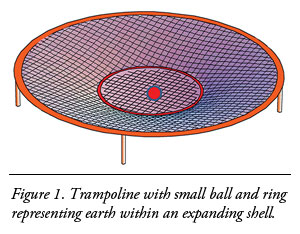 The gravitational effect of the shell of waters above the raqiaexpanding on the second day of creation can be simulated on the trampoline discussed in part 1 of this series. Remove the heavy metal ball we introduced and replace it with a pebble (representing the small ball of water that is the future earth) within a ring of metal having the same weight as the metal ball. Now there is a nearly-flat area within the ring except for a small dent made by the pebble at the center.
The gravitational effect of the shell of waters above the raqiaexpanding on the second day of creation can be simulated on the trampoline discussed in part 1 of this series. Remove the heavy metal ball we introduced and replace it with a pebble (representing the small ball of water that is the future earth) within a ring of metal having the same weight as the metal ball. Now there is a nearly-flat area within the ring except for a small dent made by the pebble at the center.
Now, let the metal ring become larger in diameter, but thinner, so that its weight stays the same. The nearly-flat area is larger, but it is also shallower. The depth of the dent caused by the ring is less than before because the ring’s weight is spread over a larger region. Thus, as God expanded the waters above the raqia, the dent in the fabric of space became shallower. This had important relativistic effects on time and space.
God called the raqia “heaven” (Genesis 1:8). At this point, the only created matter within the shell of waters above the heavens was an earth-sized ball of water. According to clues from physics, the expansion of the shell and the raqia is still happening today.2 Perhaps it was because of this unfinished state of the raqia that God did not call His creation “good” at the end of the second day, something He said at the end of each of the other five days of creation.
The Remaining Days of Creation
On the third day, God formed the waters below the firmament into the seas and dry land of planet earth, and then He made plants on the dry land. The only light source was apparently God Himself, as Psalm 104:2 suggests: “Who coverest thyself with light as with a garment.” Note that He said “light,” not “sunlight.” Contrary to the impression some people have, God’s definition of “day” in Genesis 1:5 does not require that the light source be the sun. So throughout the third day, the firmament was devoid of sun, moon, planets,3 and stars.
The new metric (solution of Einstein’s gravity equations) Humphreys developed to describe the relationship among mass, space, and time says that the distribution of mass controls the fabric of space, the fabric of space controls the speed of light, and the speed of light controls time.4 Time is speeded up or slowed down throughout space according to the distribution of mass. Figure 2 shows the relative speed of clocks as a function of gravitational potential energy and distance from the center of the cosmos where the initial mass was created. Notice that potential energy is always negative except at an infinite distance from the center of the cosmos. Also, notice that time slows down at lower potential energy until a critical value is reached. This value called the critical depth is the level below which time itself stops. This condition without time is called the achronous (no time) region.
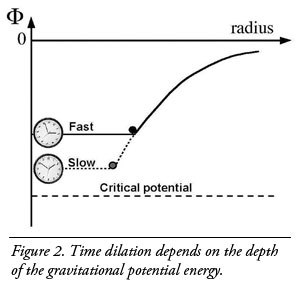 Consider the trampoline in Figure 1 again. At the end of the third day, the pebble (the earth, too tiny to be seen on this scale) and the nearly-flat part of the fabric inside the red ring were just above the critical depth. Imagine that events prior to Day Four have expanded space and moved the shell of “waters above the heavens” out to a radius of, say, one billion light years.5 This would have left the earth and the nearly-flat fabric of space within the ring just above the critical potential.
Consider the trampoline in Figure 1 again. At the end of the third day, the pebble (the earth, too tiny to be seen on this scale) and the nearly-flat part of the fabric inside the red ring were just above the critical depth. Imagine that events prior to Day Four have expanded space and moved the shell of “waters above the heavens” out to a radius of, say, one billion light years.5 This would have left the earth and the nearly-flat fabric of space within the ring just above the critical potential.
Now imagine that during the fourth day, God created star masses in a way that would form a linearly-dented perturbation in the otherwise flat potential of the fabric of space, as shown in Figure 3. There appear to be several ways to make such a shape. The linear shape shown here is not essential. It only makes illustrating the processes simpler.
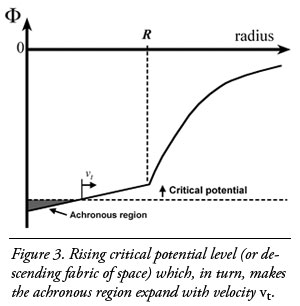 The horizontal dashed line in Figure 3 represents the critical potential. As soon as God created the galaxy masses, the fabric of space began sinking slowly and the central part—containing the earth—dropped below the critical potential. An observer in ordinary space a bit farther from the center would have seen a black sphere appear at the center of the cosmos and begin growing in size. The entire interior of the sphere was an achronous region. For slow-moving objects in that region, time would have stopped. The critical potential depends on the speed of light, which in turn depends on the tension in the fabric of space. If, as God stretched or contracted the fabric of space (Isaiah 40:22), He changed the tension simultaneously everywhere, the speed of light changed and the position of the critical potential with respect to the fabric also changed. The critical potential line in Figure 3 could have moved up or down quite rapidly.
The horizontal dashed line in Figure 3 represents the critical potential. As soon as God created the galaxy masses, the fabric of space began sinking slowly and the central part—containing the earth—dropped below the critical potential. An observer in ordinary space a bit farther from the center would have seen a black sphere appear at the center of the cosmos and begin growing in size. The entire interior of the sphere was an achronous region. For slow-moving objects in that region, time would have stopped. The critical potential depends on the speed of light, which in turn depends on the tension in the fabric of space. If, as God stretched or contracted the fabric of space (Isaiah 40:22), He changed the tension simultaneously everywhere, the speed of light changed and the position of the critical potential with respect to the fabric also changed. The critical potential line in Figure 3 could have moved up or down quite rapidly.
A Light Transit-time Scenario on Day Four
Let’s suppose the tension in the fabric of space suddenly decreased enough to make the critical potential move upward rapidly. Then, the sphere of timelessness would have expanded faster than otherwise. The speed vt of its expansion (or later, contraction) depended on three factors: the inverse of the radial slope of the potential for the fabric of space, the rate of the potential’s descent or rise, and the rate of rise or descent of the critical potential level. Other scenarios are possible, so the reader should take this as only an example of the possibilities that achronicity opens up.
For general potential shapes, let’s say that God designed or adjusted these three factors so that the expansion speed vt of the timeless zone surface was exactly at the speed of light. (Because the surface of the achronous zone is not a material object, its speed is not limited by the speed of light.) If the slope of the potential energy is constant with radius, the other two factors can be made constant in time to get a constant speed of expansion vt. For vt equal to the speed of light, the timeless zone will follow closely behind the wave of galaxy creation, proceeding outward at the speed of light. As the zone reaches and engulfs each new galaxy, time stops for that galaxy.
Suppose when the wave of new creation stopped, say at the location of the waters above, represented by the ring, God now increased the tension and the critical potential line moved downward. As it did so, the radius of the sphere of timelessness decreased. Again, let’s imagine that God set the values of the three factors to give a contraction speed at the speed of light, but this time inward instead of outward. As each galaxy emerged from the receding timeless region, 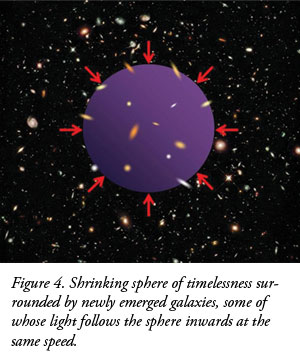 it resumed emitting light. Some of the emitted light would have gone inward toward the center. Because the timeless sphere was moving inward at the speed of light, the inbound light would follow right behind the sphere as it shrank (see Figure 4). When the sphere of timelessness reached zero radius and disappeared, the earth emerged, and immediately the light that had been following the sphere reached earth, even light that started billions of light years away. The stretching of the fabric of space had been occurring continuously all along the light trajectory, thus red-shifting the light wavelengths.
it resumed emitting light. Some of the emitted light would have gone inward toward the center. Because the timeless sphere was moving inward at the speed of light, the inbound light would follow right behind the sphere as it shrank (see Figure 4). When the sphere of timelessness reached zero radius and disappeared, the earth emerged, and immediately the light that had been following the sphere reached earth, even light that started billions of light years away. The stretching of the fabric of space had been occurring continuously all along the light trajectory, thus red-shifting the light wavelengths.
 it resumed emitting light. Some of the emitted light would have gone inward toward the center. Because the timeless sphere was moving inward at the speed of light, the inbound light would follow right behind the sphere as it shrank (see Figure 4). When the sphere of timelessness reached zero radius and disappeared, the earth emerged, and immediately the light that had been following the sphere reached earth, even light that started billions of light years away. The stretching of the fabric of space had been occurring continuously all along the light trajectory, thus red-shifting the light wavelengths.
it resumed emitting light. Some of the emitted light would have gone inward toward the center. Because the timeless sphere was moving inward at the speed of light, the inbound light would follow right behind the sphere as it shrank (see Figure 4). When the sphere of timelessness reached zero radius and disappeared, the earth emerged, and immediately the light that had been following the sphere reached earth, even light that started billions of light years away. The stretching of the fabric of space had been occurring continuously all along the light trajectory, thus red-shifting the light wavelengths.
On earth, it was still only the fourth day. An observer on the night side of the earth would have seen a black sky one instant, and a sky filled with stars the next. With a telescope he would also be able to see distant galaxies with suitably red-shifted spectra. From Day Four until now, about 6,000 years later, an observer on earth would have been able to see stars billions of light years away.
Implications and Elaborations
Although we have presented the basics of Humphreys’ new cosmology in these first two articles, it has been in an abbreviated form without equations and elaborate illustrations. In a third article, we will conclude this discussion by describing the implications of Humphreys’ cosmology in more detail using a composite figure to illustrate the effects of stretching the heavens on earth time, cosmic time, and location in space. We will also discuss a possible second time-dilation episode associated with the Genesis Flood and some cosmic evidence for the Humphreys model.
Click here to read Part 1 of the series.
Click here to read Part 3 of the series.
References
- Vardiman, L. and D. R. Humphreys. 2010. A New Creationist Cosmology: In No Time at All Part 1. Acts & Facts. 39 (11): 12-15.
- Humphreys, D. R. 2007. Creationist cosmologies explain the anomalous acceleration of Pioneer spacecraft. Journal of Creation. 21 (2): 61-70.
- We would expect the Hebrew word cochabim translated “stars” in Genesis 1:16 to include planets also, the two being indistinguishable to the naked eye. That is, the Hebrew word would mean “any tiny point of light in the heavens,” without imposing our modern distinction among such points. Comparing Amos 5:26 with Acts 7:43 supports the inclusion of planets, because most scholars think the idol in question was representing Saturn.
- Humphreys, D. R. 2008. New time dilation helps creation cosmology. Journal of Creation. 22 (3): 84-92.
- Humphreys, D. R. 1994. Starlight and Time. Green Forest, AR: Master Books, 76-77.
* Dr. Vardiman is Senior Research Scientist, Astro/Geophysics, and Dr. Humphreys is Retired Associate Professor of Physics.
Copyright © 2011 Institute for Creation Research and D. Russell Humphreys
Cite this article: Vardiman, L. and D. R. Humphreys. 2011. A New Creationist Cosmology: In No Time at All Part 2. Acts & Facts. 40 (1): 12-14.
A New Creationist Cosmology: In No Time at All Part 3
This article is the last in a series offering an explanation for how distant starlight could be visible from an earth that is only thousands of years old. Drs. Vardiman and Humphreys have contributed their considerable scientific expertise in presenting a creationist cosmology that seems to resolve this question. To read the entire series, visit www.icr.org.— Lawrence Ford, Executive Editor
Introduction
In the November 2010 and January 2011 issues of Acts & Facts, Dr. Russell Humphreys and I presented the basics of his new creationist cosmology for explaining how stars can be seen many millions of light years away if only a few thousand years of time have passed since they were created.1, 2
In this third article we will describe the implications of Humphreys’ cosmology in more detail using a composite figure that illustrates the effects of stretching the heavens on earth time, cosmic time, and the location in space. We will also discuss a possible second time-dilation episode associated with the Genesis Flood and some independent evidence for Humphreys’ model.
The Effect of Stretching the Heavens
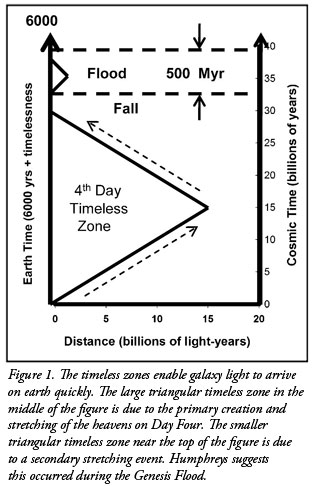 Figure 1 shows a plot of earth time and cosmic time versus distance from earth. Earth time in thousands of years is shown on the vertical axis to the left side of the diagram and cosmic time in billions of years to the right side. Cosmic time is defined as the time it takes light to travel to earth without any stretching of space or other cosmological adjustments. The distance through space is given in light years. (A light year is equivalent to the distance light travels in one year at 186,000 miles/second, or about 5.87 x 1012miles.) Light takes only about eight minutes to travel from the sun to earth, but over four light years to travel from the nearest star (Alpha Centauri). The farthest object in space observed by the Hubble telescope is estimated to be about 13 billion light years away and, consequently, the cosmic time for its light to reach earth would be about 13 billion years. However, earth time could be considerably less, according to Humphreys’ model.
Figure 1 shows a plot of earth time and cosmic time versus distance from earth. Earth time in thousands of years is shown on the vertical axis to the left side of the diagram and cosmic time in billions of years to the right side. Cosmic time is defined as the time it takes light to travel to earth without any stretching of space or other cosmological adjustments. The distance through space is given in light years. (A light year is equivalent to the distance light travels in one year at 186,000 miles/second, or about 5.87 x 1012miles.) Light takes only about eight minutes to travel from the sun to earth, but over four light years to travel from the nearest star (Alpha Centauri). The farthest object in space observed by the Hubble telescope is estimated to be about 13 billion light years away and, consequently, the cosmic time for its light to reach earth would be about 13 billion years. However, earth time could be considerably less, according to Humphreys’ model.
Ignoring the upper part of Figure 1 for the moment, the large triangular area in the center of the diagram shows the timeless zone that developed during the time that God created the galaxies and stretched space outward. It would be helpful for the reader to review the portion of the second article in January 2011 where we suggested that God designed or adjusted three factors that affected the timeless zone so that the expansion speed of the timeless zone surface was equal exactly to the speed of light. The other two factors were made constant to get a constant speed for the expansion of the timeless zone. For an expansion rate equal to the speed of light, the timeless zone would follow closely behind the wave of galaxy creation, also proceeding outward at the speed of light. As the zone reached and engulfed each new galaxy, time stopped for them. The trace of the timeless zone shown in Figure 1 would move from the lower left corner of the diagram (0, 0) [cosmic time] upward to the right center of the diagram (15, 15) [cosmic time].
When the wave of creation stopped, say at the location of the waters above, suppose that God now increased the tension, and the critical potential line (shown in Figure 3 of the second article) moved downward. As it did so, the radius of the sphere of timelessness decreased. Again, let’s imagine that God set the values of the three factors to cause the timeless zone to contract at the speed of light. As each galaxy emerged from the receding timeless zone, it resumed emitting light, some of which would shine inward toward the center. Because the timeless sphere was contracting at the speed of light, the inbound light would follow right behind the sphere as it shrank.
When the sphere reached zero radius and disappeared, the earth emerged from the timeless zone, and immediately the light that had been following the sphere reached earth, even light that started billions of light years away. The stretching of the fabric of space had been occurring continuously all along the light trajectory, thus red-shifting the light wavelengths. The trace for the timeless zone during this phase of the process moved from the right center of the diagram (15, 15) [cosmic time] to the upper left corner (0, 30) [cosmic time]. Within the timeless zone on earth during Day Four of creation, the galaxies in space would have been created and wound up, large amounts of radioactive decay would have occurred, and light would have traveled long distances from the far reaches of space. On earth, time was at a standstill during this process.
A Second Time-Dilation Episode during the Genesis Flood
As Humphreys has mentioned in several publications,3, 4 two Bible verses led him to the conclusion that there was a second space-stretching and time-dilation episode sometime during the year of the Genesis Flood. One of the verses is Psalm 18:9: “He bowed the heavens also, and came down: and darkness was under his feet.”
Here is an interesting verse:
James 3:6
And the tongue [is] a fire, a world of iniquity: so is the tongue among our members, that it defileth the whole body, and setteth on fire the course of nature; and it
is set on fire of hell.
* course - 5146; trochos; a wheel.
Strong's Exhaustive Concordance
course.
From trecho; a wheel (as a runner), i.e. (figuratively) a circuit of physical effects -- course.
* nature - 1078; genesis; origin, birth.
Strong's Exhaustive Concordance
Strong's Greek 1078 (5 Occurrences)
The other verse is 2 Samuel 22:10. It is identical, as the whole chapter is nearly identical to all of Psalm 18. The repetition suggests that the psalm is quite important. In it, David reminisces about how the Lord has rescued him from dangers. In this section of the psalm, he speaks in terms of a cataclysmic event that appears to be the Genesis Flood. Everywhere else in Scripture, the phrase here translated “bowed the heavens” is translated as “stretched out the heavens.” The primary meaning of the Hebrew verb natah is “stretched.” The translation “bowed” is far down the list of possible secondary meanings. Humphreys prefers the primary meaning, which suggests that God stretched out space at a higher-than-usual speed (as measured on earth) during the Genesis Flood.
Scientific considerations applying to the Flood suggest that time dilation occurred during this event of space stretching, and it helps explain why the stretching would appear to be very rapid as seen from earth. At the top of Figure 1 is a triangular region that occurred 1,656 years after the creation event during the year of the Genesis Flood. The expansion and contraction of this region was slower than the speed of light and only extends out to a distance of, say, a few hundred thousand light years. During the Flood year, if Noah could have seen the night sky, its appearance would have changed quickly. With a suitable telescope, he would have seen the galaxies grow older by about 500 million years (i.e., spiral galaxies would be more wound up, stars would have evolved on the Hertzsprung-Russell [HR] Diagram, supernovae would have expanded quickly, etc.). This second time-dilation event, combined with the speed-of-light recession speed of the timeless zone, explains why distant galaxies, especially spiral galaxies, look no younger than nearby ones. This scenario illustrates the usefulness of achronicity.
Cosmic Time Versus Earth Time
Because earth was in a timeless zone during the two space-stretching events, there is a major difference in the way clocks functioned on earth and in deep space. We aren’t speaking of just a minor difference. For example, if the creation of earth occurred about 6,000 years ago in earth time and the creation of objects at the edge of the universe occurred about 15 billion years ago in cosmic time, then there is a factor of about 2.5 million between the two estimates of time. This means the earth-time scale on the left side of Figure 1 cannot be drawn to scale. Time on the earth-time scale probably flowed at the same rate we observe today for about 1,656 years from the seventh day of the creation week to the Flood, and for over 4,000 years from the end of the Flood to today. The earth-time scale is compressed compared to the cosmic-time scale and has periods of timelessness in it.
Independent Evidence for Time Dilation
Humphreys explored several independent sources of evidence to support his theory that cosmic time has flowed faster than earth time. For example, he compared the age of the earth based on the diffusion rate of helium from zircons embedded in granite to the conventional estimate based on the uranium-lead decay rate. He found that the diffusion of helium from zircons shows the earth to be 6,000 ± 2,000 years old rather than 4.5 billion years based on the conventional uranium-lead age estimate of time.5
The conventional Big Bang cosmology hypothesizes that the expansion of space disperses the stars and galaxies as if they were on the surface of a sphere rather than radially from a point in space. Humphreys conducted a study of the positions of stars and galaxies throughout space and found that they were distributed in quantized concentric shells centered on our home galaxy.6 The probability of the earth having such a unique position in the cosmos by accident is less than one in a trillion. Since Big Bang theorists presuppose the cosmos has a naturalistic origin and cannot have a unique center, they have sought other explanations, without notable success. This distribution argues against the Big Bang theory and supports Humphreys’ solution upon which time dilation produces timeless zones that reconcile earth time and cosmic time.
But, probably Humphreys’ most convincing piece of evidence to support his model is his explanation for the Pioneer effect,7 an unexplained apparent anomalous acceleration of the Pioneer 10 and 11 spacecraft toward the sun. If a large volume of empty space surrounds the matter of the cosmos, so that it can have a center of mass, then the matter is in a deep gravitational potential well. If space is expanding and spreading the matter outward, then the depth of the well is decreasing. According to Humphreys’ new solution to Einstein’s equations, the decreasing depth continuously shortens distances measured by radar within the well, causing the observed acceleration. The magnitude of the anomalous acceleration implies the bottom of the potential well has not yet risen very far above the critical depth for gravitational time dilation. Thus, the Pioneer effect supports the essentials of several creationist cosmologies: a center of mass, expansion of space, and recent time dilation. Big Bang theorists, whose cosmology does not have a center of mass, cannot use this explanation.